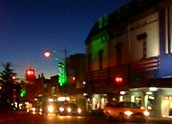

Shifting Shelter 3 (2005)
Synopsis
Shifting Shelter 3 is the latest instalment in a documentary series shot over a ten year period. Reminiscent of the British 7 Up Series, the Shifting Shelter series records the lives of four Indigenous individuals on their journey from teenagers into young adulthood, showing Willy Lamb, Cindy Petersen, Danielle Waters, and Ben Ballangarry in 1995, 2000 and now in 2005. Shifting Shelter 3 is directed by Ivan Sen, who captures the hopes and dreams of four teenagers into adulthood from 1995 to 2005.
Curator’s notes
An evocative piece that depicts the situation of four Indigenous teenagers as they grow into adulthood, some being forced to leave behind the dreams of their youth. Willy Lamb, Cindy Petersen, Danielle Waters and Ben Ballangarry share their lives with us over a ten year period from the ages of 17 to 27 years. The dreams of the teenagers are the beacon that beckons them into their future, and at the age of 17, their aspirations are unbounded. As adulthood dawns, we begin to see a sense reflection as each teenager re-evaluates their lives for the cameras.
Willy from Goodooga (population 400), speaks of becoming a singer, moving to Brisbane and going to university. Cindy from Angledool does art, swims in the river, and hasn’t ever missed a day of school. Danielle from Tamworth begins her narration with ‘they put a gun to my head’, and says ‘I might get locked up and I mightn’t’. Danielle dreams of going to America, probably Los Angeles, and going to the film studios. Ben lives in a loving environment with his father, and reminisces about getting bush tucker together and hopes to grow up to be a great man, and live a good and happy life.
The four characters chosen by Sen are all in rural environments, and are conscientious young people who, five years on, articulate how the dreams of their youth have shifted. What we witness is the journey of four people and in them, our own life journeys and how what we hope and imagine for the future, can shift, change and sometimes melt away. There is wisdom in the words of the four characters, their insights and reflections – at times philosophical and perceptive.
What we witness during this most recent installment of Shifting Shelter is the eventual collapse or reshaping of dreams, and the compromises made as a result of this. As children the characters had the whole world as their canvas upon which to imagine futures and destinies, as they grow older it is at times challenging to watch their journey and observe the consequences of their life choices and decisions. At times poignant, Shifting Shelter 3 captures very well the journey of four youths who happen to be Indigenous and live in rural areas. But while the rural locations contextualise the life stories of Willy, Cindy, Danielle and Ben, there is not a strong sense of how the surrounds have impacted upon their private dreams. Such a connection could have been valuable in order to gain a sense of the degree to which the environment impacts upon young lives and their imagined destinies. All in all, Shifting Shelter 3 does not propose to be a definitive representation of all young Indigenous peoples, and given this, it is effective in creating a space for the audience to enter into the private worlds of it’s four subjects.
- Overview
- Curator’s notes
- Video 2 clips
- Principal credits
- Find a copy
- Make a comment
- Map
- Add your review



